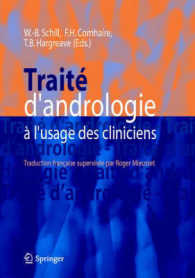- ホーム
- > 洋書
- > 英文書
- > Science / Mathematics
Full Description
The volumes of this classic series, now referred to simply as "Zechmeister" after its founder, L. Zechmeister, have appeared under the Springer Imprint ever since the series' inauguration in 1938. The volumes contain contributions in various topics related to the origin, distribution, chemistry, synthesis, biochemistry, function or use of various classes of naturally occurring substances ranging from small molecules to biopolymers. Each contribution is written by a recognized authority in his field and provides a comprehensive and up-to-date review of the topic in question. Addressed to biologists, technologists, and chemists alike, the series can be used by the expert as a source of information and literature citations and by the non-expert as a means of orientation in a rapidly developing discipline.
Contents
Bacterial Lipids Containing Amino Acids or Peptides Linked by Amide Bonds.- I. Introduction.- II. N-Acylamino Acids.- 1. N-Acyl-l-serine.- 1.1. Serratamolide.- 1.2. Flavolipin.- 2. N-Acyl-l-ornithine.- 2.1. Ornithine-containing Lipid.- 2.2. Cerilipin.- 3. Mass Spectrometry.- 4. Biological Properties.- III. N-Acylpeptides.- 1. N-Acylpeptides with a Linear Peptide Moiety.- 1.1. N-Acyldipeptides: Majusculamides A and B.- 1.2. N-Acyltetrapeptides from Rhodococcus erythropolis.- 1.3. N-Acylpentapeptides from. Mycobacterium paratuberculosis.- 1.4. N-Acyloctapeptide: Stenothricin.- 1.5. N-Acylnonapeptide: Fortuitin.- 1.6. N-Acyldecapeptides: Cerexins.- 1.7. N-Acyltridecapeptides: Tridecapeptins.- 1.8. N-Acylundecapeptide: Amphomycin.- 2. N-Acylpeptides Containing a Hydroxy Fatty Acid Involved in a Lactone Ring.- 2.1. N-Acylpentapeptide: Globomycin.- 2.2. N-Acylheptapeptides: Surfactin, Esperin and Related Compounds.- 2.3. N-Acylheptapeptides: Peptidolipin NA.- 3. N-Acylpeptides with a Lactone Ring not Involving the Hydroxyl Group of a Hydroxy Fatty Acid.- 3.1. N-Acyloctapeptides.- 3.1.1. Lipopeptins.- 3.1.2. Neopeptins.- 3.2. N-Acylnonapeptide: Viscosin.- 3.3. N-Acyldecapeptides: Imacidines.- 3.4. N-Acyltridecapeptides: Antibiotic A21978 C.- 3.5. N-Acyltetradecapeptide: Stendomycin.- 4. Peptidolipids with a Lactam Ring.- 4.1. Iturins.- 4.2. Bacillomycins.- 4.3. Mycosubtilin.- 4.4. General Comments on the Peptidolipids of the Iturin Group.- 4.5. Cyclic Peptides: Octapeptins.- 4.6. Cyclic Peptides: Antibiotic EM 49.- 5. Mass Spectrometry of N-Acylpeptides.- 6. Biological Properties of Peptidolipids.- IV. Glycosides of Peptidolipids.- 1. Glycosides of Peptidolipids Isolated from Rhodococcus erythropolis.- 2. Glycoside of N-Acylnonapeptide: Herbicolin A.- 3. Mycosides C and Related Antigenic Compounds.- 3.1. Apolar Mycosides C.- 3.2. Polar Mycosides C: Antigenic Glycopeptidolipids.- 3.3. Mycosides C as Receptors for Mycobacteriophages.- V. Conclusion.- Acknowledgements.- Addendum.- References.- Naturally Occurring Di- and Trithiophenes.- I. Introduction.- II. Nomenclature.- III. Naturally Occurring Dithiophenes: Structures.- IV. Distribution of Dithiophenes.- V. Naturally Occurring Trithiophenes: Structures.- VI. Distribution of Trithiophenes.- VII. Biosynthesis of Di- and Trithiophenes.- VIII. Synthesis of Di- and Trithiophenes.- IX. Photophysical Studies.- X. Photochemical Reactions.- XI. Biological Reactions.- 1. Effect on DNA.- 2. Antiviral Properties.- 3. Effect on Skin.- 4. Effect on Erythrocytes.- 5. Phototoxicity Toward Bacteria and Fungi.- 6. Nematocidal Activity.- 7. Trithiophenes as Insecticides.- 8. Toxicity Toward Fish and Other Aquatic Organisms.- 9. Toxicity of ?-Terthienyl Toward Plants.- XII. Conclusion.- Acknowledgement.- References.- Author Index.








